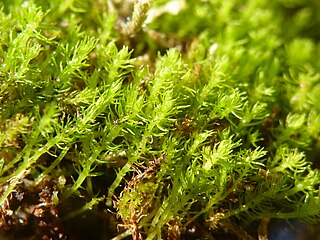
Takakia is a genus of two species of mosses known from western North America and central and eastern Asia. The genus is placed as a separate family, order and class among the mosses. It has had a history of uncertain placement, but the discovery of sporophytes clearly of the moss-type firmly supports placement with the mosses.
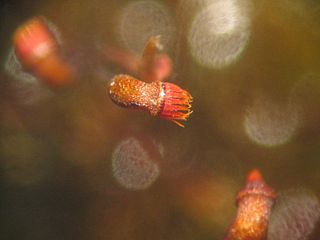
The Bryopsida constitute the largest class of mosses, containing 95% of all moss species. It consists of approximately 11,500 species, common throughout the whole world.

Sphagnopsida is a class of mosses that includes a single subclass Sphagnidae, with two orders. It is estimated it originated about 465 million years ago, along with Takakia. The order Sphagnales contains four living genera: Ambuchanania, Eosphagnum, and Flatbergium, which counts four species in total, and Sphagnum which contains the rest of the species. The extinct Protosphagnales contains a single fossil species.

The Funariidae are a widespread group of mosses in class Bryopsida. The majority of species belong to the genera Funaria and Physcomitrium.

Pottiales is an order of mosses in the subclass Dicranidae.

Andreaeobryum is a genus of moss with a single species Andreaeobryum macrosporum, endemic to Alaska and western Canada. The genus is placed as a separate family, order and class among the mosses.

Tetraphidaceae is a family of mosses. It includes only the two genera Tetraphis and Tetrodontium, each with two species. The defining feature of the family is the 4-toothed peristome.
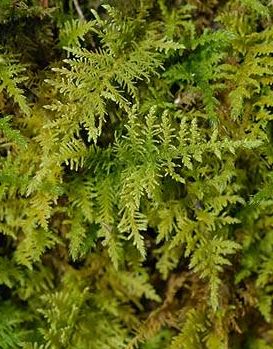
Hypnales is the botanical name of an order of Bryophyta or leafy mosses. This group is sometimes called feather mosses, referring to their freely branched stems. The order includes more than 40 families and more than 4,000 species, making them the largest order of mosses.

Bryaceae is a family of mosses.
Neosharpiella is a genus of moss containing two species in the family Bartramiaceae. The type species, Neosharpiella aztecorum, grows in alpine regions of central Mexico, while the other species, Neosharpiella turgida, has been found in Bolivia and Ecuador.

Itatiella ulei is a species of moss in the family Polytrichaceae. It is the only species in the genus Itatiella. The Polytrichaceae is a common family of mosses that does not have close living relatives. Its small size and the inflexed leaf apex characterize Itatiella ulei. When this species grows directly exposed to sun at high elevations, it presents a similar aspect but can be distinguished based on the distal lamella cells which are single and rhombic.

Calliergon cordifolium is a species of moss in the Calliergonaceae family, commonly known as the calliergon moss or heart-leaved spearmoss. The species is abundant in the right habitat, and grows in marshes and wet woodland, especially woodland of alder (Alnus) or willow (Salix), as well as around streams, ditches and pools. The species grows in tufts among other moss species. Calliergon cordifolium requires a wet environment to grow, and often grows completely submerged in water. It typically prefers lowland, but has been recorded as high as 910 metres (1,000 yd) above sea level in Inverness, Scotland. The species has a circumpolar Boreo-temperate distribution. It is found throughout Europe. It has been recorded in north and central Asia, as well as Turkey and Japan, throughout North America and in New Zealand.
Pseudoditrichum is a rare North American genus of haplolepideous moss (Dicranidae). It is the only known genus in its family (Pseudoditrichaceae), and there is only one species in the genus. Pseudoditrichum mirabile has been found only in a small area along the Sloan River near Great Bear Lake. This is in the Northwest Territory in northern Canada, only a few kilometers south of the Arctic Circle.
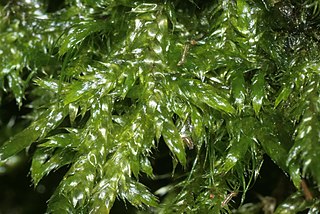
Sematophyllaceae is a family of mosses, known commonly as signal mosses. They grow on rocks in wet or humid places. and are found nearly worldwide, especially in tropical and temperate regions. There are about 150 species, which form yellow to yellow-green mats with reddish stems.

Pleurophascum grandiglobum is a moss endemic to Tasmania, Australia, and was first noted by S. O. Lindberg in 1875 for its peculiar form of cleistocarpous capsule, erect growth form, lateral perichaetia, and ecostate leaves. Its exceedingly large, inoperculate, and often brightly coloured capsules captured the heart of the 19th-century Scandinavian bryologist, who considered the moss to be "of no less interest to the Museologist than is Rafflesia or Welwitschia to the Phanerogamist". The species currently belongs to a monogeneric family Pleurophascaceae that is found only in temperate Australasia and includes three different species. Pleurophascum ovalifolium, heretofore known as P. grandiglobum var. decurrens, is the New Zealand taxon while the last remaining member of the genus, Pleurophascum occidentale, occurs only in Western Australia.
Seligeria cardotii is one of the two species in genus Seligeria, bryophytes of the Seligeriaceae family, in the Southern Hemisphere; an additional 19 species have been described in the Northern Hemisphere.
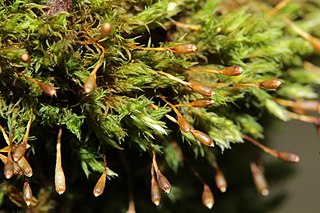
Ulota is a genus of mosses comprising 69 species with a worldwide distribution, though most species are found in the southern hemisphere.

Ditrichaceae is a family of haplolepideous mosses (Dicranidae) in the order Dicranales.
Wilfred "Wilf" Borden Schofield (Botanist) was a Canadian botanist, specializing in mosses and liverworts. He was considered by many "the foremost bryologist in Canada".
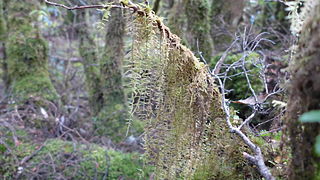
Wijkia is a genus of mosses belonging to the family Pylaisiadelphaceae, with its species found in Southeastern Asia, Africa, Australia and America.




















